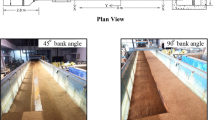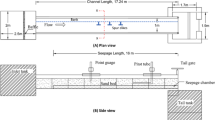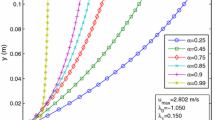Abstract
In open channel flow, the velocity distribution is required to analyze the flow parameters such as discharge, energy and momentum correction factors, and scour depth. Though the existing technique can simulate the velocity distribution practically sound, the hypothesis on the cumulative distribution function of velocity is difficult to track and restricted by several factors that it holds. The paper aims to extend the entropy-based 1-D velocity distribution to rectangular seepage channels, considering the cumulative distribution function based on channel geometry. The present work developed a Tsallis and Shannon entropy-based model for proposing 1-D velocity distributions in seepage-affected alluvial channels. The velocity distributions were evaluated with laboratory observations and were compared with Shannon and Tsallis entropy-based velocity distributions equation. The Shannon and Tsallis entropy-based 1D velocity distributions agreed with experimental data satisfactorily and compared well. However, based on the regression analysis, Tsallis-based velocity distribution performed better than the Shannon-based entropy model.







Similar content being viewed by others
Data availability
Some or all data, models, or codes that support the findings of this study are available from the corresponding author upon reasonable request.
References
Afzalimehr H, Rennie CD (2009) Determination of bed shear stress in gravel-bed rivers using boundary-layer parameters. Hydrol Sci J 54(1):147–159
Berenbrock C (1999) Streamflow gains and losses in the lower boise river basin, Idaho. US Geological Survey Water-Resources Investigations Report. 1996-97. 99–4105
Cao D, Chiew YM (2014) Suction effects on sediment transport in closed conduit flows. J Hydraul Eng 140(5):04014008
Carlson RA, Petrich CR (1999) New York Canal geologic cross-section, seepage gain/loss data, and ground water hydrographs: compilation and interim findings. Treasure Valley Hydrologic Project Open File Report.
Chen X, Chiew YM (2004) Velocity distribution of turbulent open-channel flow with bed suction. J Hydraul Eng 130(2):140–148
Chiu CL (1987) Entropy and probability concepts in hydraulics. J Hydraul Eng 113(5):583–599
Chiu CL (1988) Entropy and 2-D velocity distribution in open channels. J Hydraul Eng 114(7):738–756
Chiu CL, Said CAA (1995) Maximum and mean velocities and entropy in open-channel flow. J Hydraul Eng 121(1):26–35
Chiu CL, Tung NC (2002) Maximum velocity and regularities in open-channel flow. J Hydraul Eng 128(4):390–398
Cui H, Singh VP (2013) Two-dimensional velocity distribution in open channels using the Tsallis entropy. J Hydrol Eng 18(3):331–339
Cui H, Singh VP (2014) One-dimensional velocity distribution in open channels using Tsallis entropy. J Hydrol Eng 19(2):290–298
Deshpande V, Kumar B (2017) Effect of downward seepage on the shape of an alluvial channels. Proc ICE-Water Manag 170(1):3–14
Devi TB, Sharma A, Kumar B (2019) Flow characteristics in a partly vegetated channel with emergent vegetation and seepage. Ecohydrol Hydrobiol 19(1):93–108
Faruque MAA, Balachandar R (2011) Seepage effects on turbulence characteristics in an open channel flow. Can J Civ Eng 38(7):785–799
Jaynes ET (1957) Information theory and statistical mechanics. Phys Rev 106(4):620
Lu Y, Chiew YM, Cheng NS (2008) Review of seepage effects on turbulent open-channel flow and sediment entrainment. J Hydraul Res 46(4):476–488
Luo H, Singh VP (2011) Entropy theory for two-dimensional velocity distribution. J Hydrol Eng 16(4):303–315
Marini G, De Martino G, Fontana N, Fiorentino M, Singh VP (2011) Entropy approach for 2D velocity distribution in open-channel flow. J Hydraul Res 49(6):784–790
Martin CA, Gates TK (2014) Uncertainty of canal seepage losses estimated using flowing water balance with acoustic Doppler devices. J Hydrol 517:746–761
Mihailović D, Mimić G, Gualtieri P, Arsenić I, Gualtieri C (2017) Randomness representation of turbulence in canopy flows using Kolmogorov complexity measures. Entropy 19(10):519
Nezu I, Tominaga A, Nakagawa H (1993) Field measurements of secondary currents in straight rivers. J Hydraul Eng 119(5):598–614
Pathak K, Pandey KK, Singh VP (2020) Entropy-Based Velocity and Shear Stress Distributions for Trapezoidal Channel. J Hydrol Eng 25(11):04020047
Pope SB (2000) Turbulent flows. Cambridge University Press, Cambridge
Rao AR, Sreenivasulu G, Kumar B (2011) Geometry of sand-bed channels with seepage. Geomorphology 128(3–4):171–177
Richardson CP, Abt SR, Richardson EV (1985) Inflow seepage influence on straight alluvial channels. J Hydraul Eng ASCE 111(8):1133–1147
Shannon CE (1948) A mathematical theory of communication. Bell Sys Techn J 27(3):379–423
Sharma A, Kumar B (2016) Probability distribution functions of turbulence in seepage-affected alluvial channel. Fluid Dyn Res 49(1):015508
Sharma A, Kumar B (2017) Structure of turbulence over non uniform sand bed channel with downward seepage. Eur J Mech-B/fluid 65:530–551
Sharma A, Kumar B (2018) High-order velocity moments of turbulent boundary layers in seepage affected alluvial channel. ASME J Fluid Eng. https://doi.org/10.1115/1.4039253
Sharma A, Mihailović DT, Kumar B (2018) Randomness representation of Turbulence in an alluvial channel affected by downward seepage. Physica A 509:74–85
Sharma A, Herrera-Granados O, Kumar B (2019) Bedload transport and temporal variation of non-uniform sediment in a seepage-affected alluvial channel. Hydrol Sci J 64(8):1001–1012
Sharma A, Huang L, Fang H, Li X (2020) Effects of hydrodynamic on the mobility of phosphorous induced by sediment resuspension in a seepage affected alluvial channel. Chemosphere 260:127550
Singh VP, Luo H (2011) Entropy theory for distribution of one-dimensional velocity in open channels. J Hydrol Eng 16(9):725–735
Singh VP, Sivakumar B, Cui H (2017) Tsallis entropy theory for modeling in water engineering: a review. Entropy 19(12):641
Tanji KK, Kielen NC (2002) Agricultural drainage water management in arid and semi-arid areas. FAO, Roma (Italia)
Tsallis C (1988) Possible generalization of Boltzmann-Gibbs statistics. J Stat Phys 52(1):479–487
Vyas JK, Perumal M, Moramarco T (2020) Discharge estimation using Tsallis and Shannon entropy theory in natural channels. Water 12(6):1786
Welch PD (1967) The use of fast fourier transform for the estimation of power spectra: a method based on time averaging over short, modified periodograms. IEEE Trans Audio Electroacoust 15(2):70–73
Yang SQ, Tan SK, Lim SY (2004) Velocity distribution and dip-phenomenon in smooth uniform open channel flows. J Hydraul Eng 130(12):1179–1186
Yussuff SMH, Chauhan HS, Kumar M, Srivastava VK (1994) Transient canal seepage to sloping aquifer. J Irrig Drain Eng 120(1):97–109
Funding
The authors have not disclosed any funding.
Author information
Authors and Affiliations
Corresponding author
Ethics declarations
Conflict of interest
The authors declare that they have no conflict of interest.
Additional information
Publisher's Note
Springer Nature remains neutral with regard to jurisdictional claims in published maps and institutional affiliations.
Rights and permissions
About this article
Cite this article
Sharma, A., Jha, V., Roy, M. et al. One-dimensional velocity distribution in seepage channel using Tsallis and Shannon entropy. Stoch Environ Res Risk Assess 36, 3255–3264 (2022). https://doi.org/10.1007/s00477-022-02192-4
Accepted:
Published:
Issue Date:
DOI: https://doi.org/10.1007/s00477-022-02192-4




